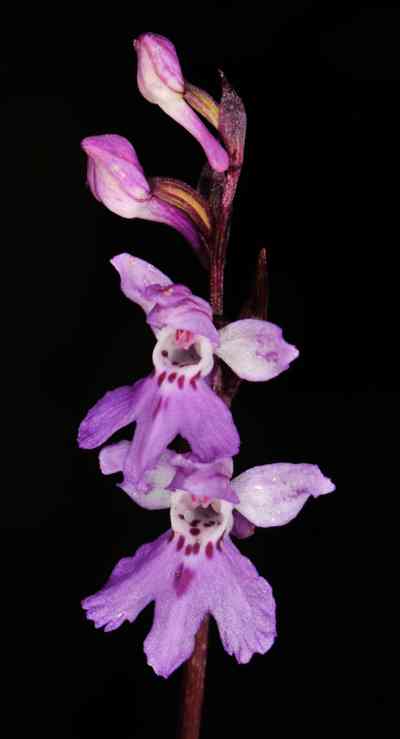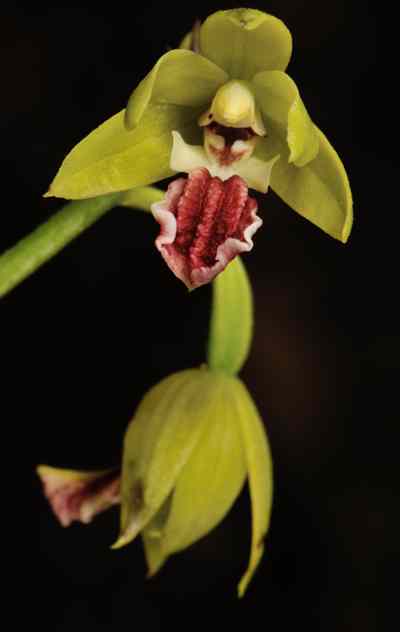The Plant
Terrestrial. Whole plant 6 to 9 cm in height. Tuber single, 0.75 to 1 cm long and less than 0.75 cm in width at its widest part, ovate to orbicular, with 3 to 4 short and thick roots arising from it along with a few thin fibrous roots. Stem cylindrical, thick, arising from the apex of the bulb and less than one-third in height of the whole plant, covered with the petiole of the leaf and with a long clasping lanceolate sheath at its base. Leaf solitary, arising from the apex of the stem, lanceolate to oblanceolate, 2 to 3 cm long and 1.2 cm in width at its widest part, sessile, base clasping and narrowed to a long petiole. Flowers two, arranged at the topmost portion of a long cylindrical and faintly ribbed terminal spike, secund.
The Flower
Flowers large, 2.5 to 3 cm long diagonally. Sepals un-equal, the dorsal much smaller than that of the lateral. Dorsal sepal oblanceolate, diagonally erect and not touching the petals, its base margins curved forward to form a wide boat like structure. Lateral sepals larger than the dorsal, ovate, spreading and curved upwards, margins undulate and sickle shaped at its base. Petals as long as the dorsal sepal, oblong to oval, curved forward with its apex overlapping or touching each other. Lip longer and wider than the lateral sepals, obcordate in outline, with faintly cut apex forming mid and side lobes; apex of both mid and side lobes rounded. Spur as long as the ovary and the lip, cylindrical, straight, slightly compressed. Floral bract lanceolate, erect, longer than the ovary but diminishing to less than half in length in the apex flower and arising from the upper base of it.
Stem pink at its base turning dark brown towards its apex, the sheath at the base of the stem is creamy white with brown reticulations. Floral spike pale green at its base and turning dark pink towards its apex.
Sepals and petals pink to dark rose. Lip of the same shade but with irregular dark shaded patches and white markings at its base surrounding the mouth of the spur. Spur pale pink. Ovary brownish pink. Floral bract dark brown to reddish brown.
Note: Described as Orchis chusua Don. var nana King and Pantling., by the authors in the Ann. Roy. Bot. Gard. (Calcutta) 8:304 (1898), during their monumental work on orchids from the region of Sikkim-Himalayas. Later on, many authors moved the variety to Gymnadenia and Ponerorchis, with some retaining it as Orchis. According to present Kew Database on World Checklist of Selected Plant Families, the variety got merged with the Ponerorchis chusua (D.Don) Soó., which is entirely another plant growing at a different altitude and habitat with all together different characteristics. This author is of the concerned opinion, by discovering the variety again and conducting a detailed in-situ study, that the above variety should be described as Ponerorchis nana (King and Pantling) Soó. (Reference: Acta Bot. Acad. Sci. Hung. 12:353 (1966)). Interestingly, the plant has its own Alba, thus making it a species by its own characteristics.

The Pursuit
A plant which went undocumented for some 125 years after its first report from the region of Sikkim-Himalayas. Even after several exploration and expedition trips year after year in the region by many research scholars, the variety remained untraced, thus was merged with its species form.
I was not able to find any related documents or photographs of this variety during my pre-survey work. However, the variety was a top priority in my list of pursuit.
After a thrilling trek I succeeded to find the species form, that too by the second half of the flowering season. As the flowering season would be over soon, I was of the opinion that the variety may not be found. By the end of the third month, I was regularly accompanied by a very kindhearted forest staff. We regularly took uphill drive, courtesy Army convoy, and surveyed many new areas every day. The results were amazing with many new finds.
We planned a trip to one of the most remote valleys of the region by the end of the third month. The valley was around 27 km of trek from the place of last motorable road. The only human settlements in the valley were of security people guarding the borders. Hence, entry and research into that valley were highly restricted and needed multiple permissions from various agencies. Luckily, I was granted permission to work there. However, the other official who accompanies me was denied permission by the authorities. Thus I was left all alone to work in that remote area.
It took almost 13 hours of trek for me to reach there. Even though I encountered many plants in flower, I was left with no option than walking as fast as I could, so to reach the camp before sun set. Next day morning, I ventured into the valley, a real botanical paradise. The long trek of the previous day has made my feet swollen; it was very difficult to fit both my feet into my boots. I was forced to borrow a bigger sized boot of a soldier from the camp. Even with those swollen feet I took a trek along the only stream of the valley. Thousands of flowers were in full bloom all along the river. I felt it would be better to crawl along the ground so that I would not miss any of those flowers. Interestingly no orchids were spotted for the first three hours of my survey in that new world.
As I was returning to the camp for lunch, I met a patrol party of soldiers returning to the camp after their routine border patrol. As always, soldiers raise a lot of question regarding any outsider’s visit. While explaining to them about my nature of duty, one of them took his mobile and shown me some photographs of flowers he had captured. I was so disappointed to see no orchid photograph from his hundreds of flower photographs. In return of his generosity, I took out my Ipad to show them my photograph collections of orchids. As they were going through the photographs, I explained to them what an orchid look like. Suddenly, he opened his mobile again to show a few other photographs he stored in another folder. They were only a few, but one of them, a damaged plant was like the one I was looking for – the variety which was unheard and unseen for more than a century. However, he was not able to remember from where he found the plant.
As I was determined to locate the plant, I planned my next three in such a way that I could cover most of the areas. The first day went without any trace of the plant even after surveying many miles. The second day was disrupted with morning showers, later on, the day became clear with sunshine and I was out to another location in search of the plant. The day ended without any success, even though some other interesting Alpine flowers were spotted.
On the third day, I went to a higher open meadow, which had a small lake in the middle. As I was walking along its bank, I spotted few very small plants with pink to rose flowers growing next to some small scattered rocks. They were hardly 5 to 7 cm in height. I never thought next moment I am going to create history by re-discovering a plant not found for more than a century. I went near to the plant and on close observation I was sure it was the one I was looking for. The find made me speechless; the joy boundless. I settled down on the ground to normalize my heartbeat and breathe and produced some real great photographs of the plant.
Reference:
King, G. & Pantling, R. (1898). The Orchids of the Sikkim-Himalayas. Ann. Roy. Bot. Garden. (Calcutta). Orchis chusua Don. var nana King and Pantling., Page no 304.



